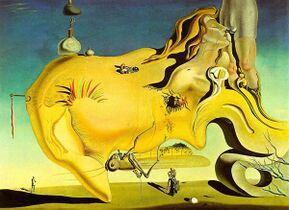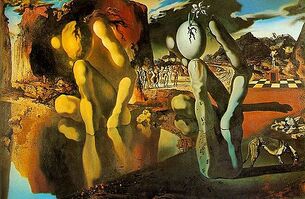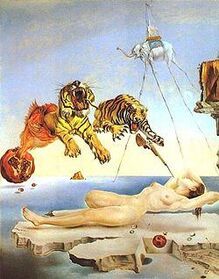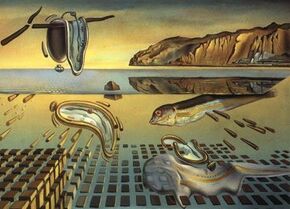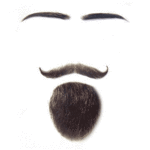Salvador Dalí
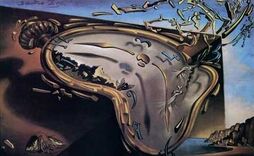
“God failed but Dali endures”
“Picasso you say? A fake imposter, a poseur...I am the genuine fraud”
“There are fourteen ways to blow a mosquito into the eye of Neptune, and hamsters sleep with the idea of a salt bath.”
Salvador Dalí was born “Salvador Domingo Felipe Jacinto Dalí i Domenech, Marquis of Pubol” in Spain in 1904. Dalí was like any normal person. He lived with his disciplinarian father, and his over-compensating mother, where he learned the values he held dear. Dalí upheld good practices such as eating your vegetables, drinking your milk, spitting on your toothbrush and not your dead mother's portrait, saying your prayers, and taking vitamins. He did this, like everything else, without complaining. Unlike Pablo Picasso who broke every rule from day one.
Given the length of his name, Dalí was unable to find a career in the mundane. With no skills to help him make money, he decided to earn even less money by his “art”. His unique perspective made his entry into the art world a given while his motivations were as cliché as any other artist: Being a famous painter gets you free drinks and a lot more girls go home with you.
Biography
Early life
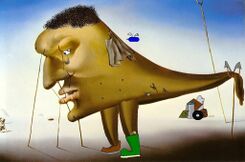
Salvador Dalí was born Catalonia, Spain, May, 1904, nine months after his older brother, also called Salvador passed away. This suggests that Dalí's parents were the kind of people who would mark the death of a child with a vigorous night of lovemaking. Given that this was his parentage, Dalí didn't even have a chance at a normal childhood and the bullies – including his father - sensed this with their sensitive fists.
Dalí attended drawing school from a young age, encouraged by his mother who fawned over the boy and encouraged his every whim. This had an adverse effect on the young Dalí, giving him delusions of grandeur from a young age. In 1917 he held his first exhibition of his charcoal drawings in his family home, as he did not have access to DeviantART at this stage.
In 1921, when he was only 16, Dalí's mother passed away before he could realise that her opinion of him was probably based on a maternal bond rather than a realistic perspective of the world. Dalí's father shortly moved in with his deceased wife's sister, as moving on to the next family member was part of their genetic makeup. This is just one of many reasons Dalí sweetened his coffee with absinthe.
Madrid and Paris
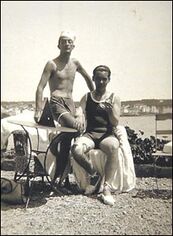
Dalí moved out of the family home in 1922 - possibly to avoid having to listen to his father giving it to his aunt regularly - and moved into art college in Madrid as he had no ability for anything constructive.
While at art college he befriended Federico García Lorca, who was both a poet and a homosexual. Lorca did try to make moves on Dalí, who later claims that nothing happened between them, while at the same time saying that he did not like anal sex because it hurt, and not in the psychologically scarring way he liked. He did however have a strong bond with Lorca - after all everyone likes a gay poet.
Dali was expelled from the college in 1926 after causing “unrest” by painting a gigantic cock and balls on the walls of the ladies bathrooms. Being Dali, he of course had them walking around on stilts, with dog's mouths, and as he usually did, covered them in ants. The college ceremonially burnt all of Dali's sketch books as a hint he would not be coming back.
That same year he moved to Paris to meet and work with one of his heroes, Pablo Picasso. Dali's artworks at the time were heavily influenced by Picasso - probably not from watching but to avoid Picasso whining to him all the time about how he kept making the same mistake of having the eyes on different sides of the face.
Before the war
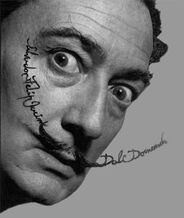
In August 1929, Dalí met his muse, inspiration, and girl gullible enough to sleep with him: Gala. Born Elena Ivanovna Diakonova, she was a Russian immigrant ten years his senior, showing Dalí's relationship with older women who resembled his mother was not exactly healthy. Whe the two met she was married to surrealist poet Paul Éluard, adding further credibility to the claim that she was actually Dalí's lady-beard.
Dalí's father, (Don Salvador Dalí y Cus, as the family were big on recycling names,) disapproved of the relationship between his son and the Russian - potentially because they were having sex even before anyone was dead. The Don also disliked Dalí's friends, who he felt were a bad influence on his little boy.
Salvador Dalí was violently thrown out of his father's home on the 28th December, 1929. The Don also told his son never to return to his home town, and that he would be disinherited. So by this stage in his life Dalí had slept with his maternal replacement and fought with his paternal figure. It is unknown if Dalí has ever read Oedipus Rex, however it is likely he could have written something very similar.
Dalí also officially become part of the surrealist movement, even though his artwork had been surreal in style for a significant period before hand. Later in life Dalí stated: “The only difference between me and the surrealists is that I am a surrealist.”
However, he also said: “The only difference between me and a madman is that I am not mad.” This suggests that Dalí only saw distinctions between himself and others where it was to his benefit. That, and he was an egocentric prat.
These kind of statements did not go down well with the other surrealists, along with Dalí refusing to denounce Hitler. In 1934 Dalí was formally expelled from his surrealist group.
The flimsy threads of his sanity slipped away from him over the next few years. He married Gala in a civil ceremony. He announced that he was surrealism, suggesting that he was an entire art movement, and accusing others of stealing his work directly from his subconscious.
In 1938 Dalí was introduced to Sigmund Freud. Details of their discussions are unavailable due to doctor patient confidentiality, as well as the fact that they are both dead and not as chatty as they used to be.
United States
Years progressed, as they have a distressing tendency to do, and World War II broke out. Dalí, in 1940, decide that his art could not thrive in an country at war, or if he ended up as a civilian casualty. With amazing foresight he moved to a country that would not become involved in a European/Asian conflict no matter what happened - the United States of America.
During his eight year stay he renewed his faith in a religion that worshipped a maternal figure, and celebrate the son supplanting his father by becoming him - Catholicism. This suggests whatever Freud said, it probably didn't work.
Dalí was accused by other artists at the time of being too focused in commercialism and self-aggrandisement. He was even given the psuedonym “Avide Dollars” - a phonetic spelling of the French avide à dollars meaning “money hungry prat”, and an anagram of his shortened name. To disprove this Dalí wrote his autobiography, at 38, called “The secret life of Salvador Dalí” (which is still commercially available).
Back to Catalonia
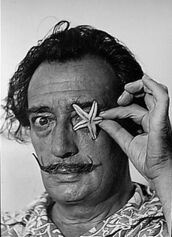
From 1949 onwards, Dalí spent his remaining years back in his mother country (no pun intended). Dalí stated around this time “I do not do drugs. I am drugs.” His friends tried to snort him later that night. It didn't work well for them, but Dalí thoroughly enjoyed the experience and was sad when it was over.
According to some eyewitness accounts, Dalí subjected himself to an exorcism at this stage. This was obviously the act of a man who was truly in his right mind, and not the act of a drug addled weirdo at all.
At this stage in his career, Dalí did not confine himself to painting, but experimented with many unusual or novel media and processes, shadowing a lack of artistic ability by overshadowing it with technical wizardry.
In the late 60's, Dalí returned to his artistic roots. This included having art critic Brian Sewell lying down in the fetal position without trousers in the armpit of a figure of Christ and masturbating, while pretended to take photos while fumbling in his own trousers. However Dalí was definitely not a closet homosexual racked with Catholic guilt or an Oedipal complex at all.
Dalí also continued to prove that he was not an egotist who was primarily motivated by commercial gain, by writing and appearing in an advertisement for Lanvin Chocolates, designing the Chupa Chup logo, or the Eurovision song contest advertising campaign.
In 1975, Dalí narrated and designed the Disney film “Impressions of Upper Mongolia” - a story about an expedition in search of giant hallucinogenic mushrooms. The imagery was based on microscopic uric acid stains on the brass band of a ballpoint pen on which Dalí had been urinating for several weeks. Dalí was definitely not a drug addled freak at all, however.
His health took a tragic turn in 1980, however, when a cocktail of unprescribed medications led to irreparable damage to his nervous system, and ending his artistic endeavours. Not that he was a junkie at all - it was definitely his near-senile wife giving them to him “by accident”. After all, it's always in your best interest to obtain unprescribed medications and leave them where your senile nurse can give them to you without you questioning once what it is you are taking.
King Juan Carlos of Spain bestowed on Dalí the title of Marqués de Dalí de Púbol, as his name wasn't long enough already. To show his gratitude he gave the king his final artwork, “The head of Europa”, because it's always a lovely thing to get a gift of artwork from someone who doesn't have full hand-eye coordination. The king was given this when he visited Dalí's bedside in hospital, which meant the conversation quickly became “That's lovely. And what is that blob over there?”
Gala passed away in 1982. Dalí then appeared to lose the will to live, but being a staunch Catholic he was unable to commit suicide directly. He attempted to end his life by dehydrating himself, and then trying to set his bedroom on fire. As successful in ending his life as he was in living it, he ended up surviving for another six and a half years, finally passing away from heart failure on 23rd January, 1989.
Artwork and Symbolism
The Great Masturbator (1929)
Again, Dalí uses the rocks at the beach as inspiration for part of this image, but this time as a distorted face looking down. A nude female figure, resembling his new muse at the time, Gala, and also having some resemblance to his mother, seems to be extruding itself from the “hind mind” of the face, suggesting that the fantasy is coming directly from the deeper subconscious of the fantasiser.
The woman's nose is near the thinly veiled male crotch, suggesting either fellatio is soon to take place, or that the bulge in the male's pants is actually Lanvin chocolate. Later in life Dalí stated as part of an advertisement for chocolate “Je suis fou de chocolat Lanvin!” (I'm crazy about Lanvin chocolate), which suggests that this may have been a precursor to his lust for commercialisation and profit.
The egg appears which represents the prenatal and intrauterine, thus using it to symbolize hope and love, as hope and love spring from the maternal.
A locust is shown on the underside of the face, with a swarm on ants on it's abdomen, and more ants on the face. Dalí was irrationally terrified of locusts, and often used ants in his paintings as a symbol for death, as well as a symbol of female genitalia. So Dalí related female genitals with death. But he was definitely not crazy, or homosexual.
Metamorphosis of Narcissus (1937)
The mythology of Narcissus was a young man who was so in love with himself that he stared at his own reflection for so long that he wasted away. The Gods took pity on him and immortalised him as a flower. There are no prizes available for working out why Dalí was fascinated by this myth.
The inspiration apparently comes from Dalí overhearing a conversation between two local fisherman discussing some who was so vain he would stare at himself in the mirror for hours. One of them commented he had a “bulb in his head”, a euphemism for being crazy. There are no prizes for guessing who they were discussing.
Dalí again uses ants as a symbol for death and decay, along with a scavenging dog, who also resembles the same thing. The hand, which is a reflection of the figure on the left, holds an egg, although in this case it's also referred to as a “bulb”, which may reflect insanity. Suggesting that Dalí may be inferring that insanity comes from the not from nature, but from nurture – specifically from his mother.
Dream Caused by the Flight of a Bumblebee around a Pomegranate a Second Before Awakening (1944)
Next to the naked image of Gala, Dalí's wife, levitating above the rock, is a pomegranate, which is the Catholic symbol of fertility and resurrection. Above the pomegranate is a bee, which represents the virgin mother. So it's so far all about religion, sex, and motherhood, which is not exactly a change from most of his paintings.
To the left of the image is a pomegranate exploding and forming a yonic opening, out of which is coming a fish with a yonic mouth. Out of that is coming a tiger, out of which is coming an identical tiger, almost as if out of the death of the first tiger comes it's reincarnation, similar to Dalí's belief that he was the reincarnation of his dead brother who had the same name. The tiger also has similar colouring to the bee, which is the Virgin mother. Out of the mouth of the second tiger comes a rifle, which is generally a phallic symbol, as well as a symbol of death, and adorning the rifle is a bayonet, which is also a phallic symbol and a symbol of death, and that is about to penetrate Gala's flesh. Behind all of this is an elephant - a phallic symbol - on stilts - a phallic symbol - carrying an obelisk - a phallic symbol.
Insert your own psychological analysis here.
The Disintegration of the Persistence of Memory
Salvador Domènec Felipe Jacinto Dalí i Domènech, Marqués de Dalí de Púbol was as crazy as the proverbial loon with significant mother issues, delusions of grandeur, and substance abuse problems. There could be a number of explanations of what's happening here, but the reality is he could have been attempting his own version of Van Gogh's sunflowers, and this is what his disturbed mind spat out.
Make up your own interpretation here.
See Also
| ||||||||||
| Featured version: 12 May 2012 | |
| This article has been featured on the main page. — You can vote for or nominate your favourite articles at Uncyclopedia:VFH. | |

